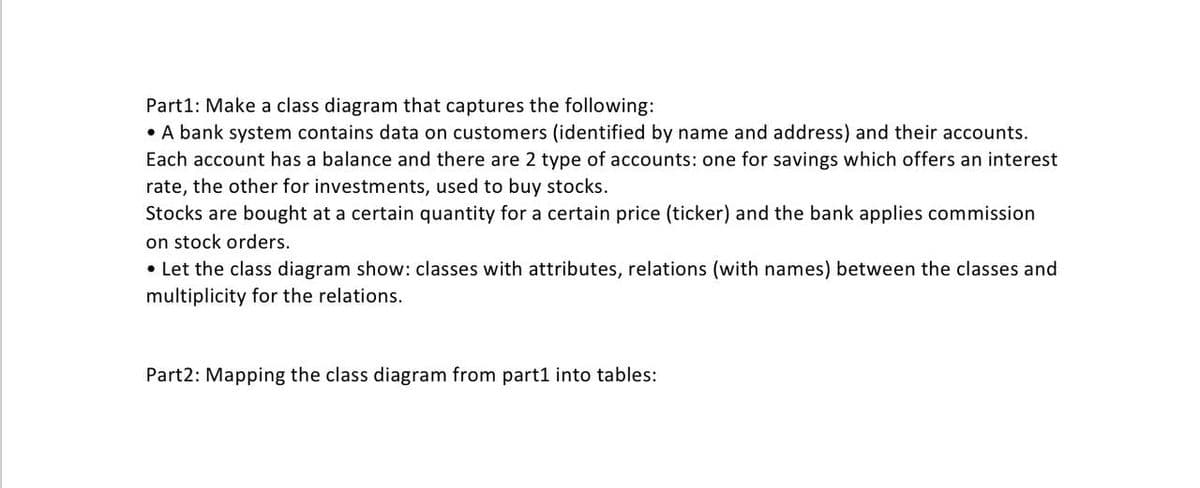Part1: Make a class diagram that captures the following: • A bank system contains data on customers (identified by name and address) and their accounts. Each account has a balance and there are 2 type of accounts: one for savings which offers an interest rate, the other for investments, used to buy stocks. Stocks are bought at a certain quantity for a certain price (ticker) and the bank applies commission on stock orders. • Let the class diagram show: classes with attributes, relations (with names) between the classes and multiplicity for the relations. Part2: Mapping the class diagram from part1 into tables:
Part1: Make a class diagram that captures the following: • A bank system contains data on customers (identified by name and address) and their accounts. Each account has a balance and there are 2 type of accounts: one for savings which offers an interest rate, the other for investments, used to buy stocks. Stocks are bought at a certain quantity for a certain price (ticker) and the bank applies commission on stock orders. • Let the class diagram show: classes with attributes, relations (with names) between the classes and multiplicity for the relations. Part2: Mapping the class diagram from part1 into tables:
Computer Networking: A Top-Down Approach (7th Edition)
7th Edition
ISBN:9780133594140
Author:James Kurose, Keith Ross
Publisher:James Kurose, Keith Ross
Chapter1: Computer Networks And The Internet
Section: Chapter Questions
Problem R1RQ: What is the difference between a host and an end system? List several different types of end...
Related questions
Question

Transcribed Image Text:Part1: Make a class diagram that captures the following:
• A bank system contains data on customers (identified by name and address) and their accounts.
Each account has a balance and there are 2 type of accounts: one for savings which offers an interest
rate, the other for investments, used to buy stocks.
Stocks are bought at a certain quantity for a certain price (ticker) and the bank applies commission
on stock orders.
• Let the class diagram show: classes with attributes, relations (with names) between the classes and
multiplicity for the relations.
Part2: Mapping the class diagram from part1 into tables:
Expert Solution
This question has been solved!
Explore an expertly crafted, step-by-step solution for a thorough understanding of key concepts.
Step by step
Solved in 2 steps with 2 images

Recommended textbooks for you

Computer Networking: A Top-Down Approach (7th Edi…
Computer Engineering
ISBN:
9780133594140
Author:
James Kurose, Keith Ross
Publisher:
PEARSON

Computer Organization and Design MIPS Edition, Fi…
Computer Engineering
ISBN:
9780124077263
Author:
David A. Patterson, John L. Hennessy
Publisher:
Elsevier Science

Network+ Guide to Networks (MindTap Course List)
Computer Engineering
ISBN:
9781337569330
Author:
Jill West, Tamara Dean, Jean Andrews
Publisher:
Cengage Learning

Computer Networking: A Top-Down Approach (7th Edi…
Computer Engineering
ISBN:
9780133594140
Author:
James Kurose, Keith Ross
Publisher:
PEARSON

Computer Organization and Design MIPS Edition, Fi…
Computer Engineering
ISBN:
9780124077263
Author:
David A. Patterson, John L. Hennessy
Publisher:
Elsevier Science

Network+ Guide to Networks (MindTap Course List)
Computer Engineering
ISBN:
9781337569330
Author:
Jill West, Tamara Dean, Jean Andrews
Publisher:
Cengage Learning

Concepts of Database Management
Computer Engineering
ISBN:
9781337093422
Author:
Joy L. Starks, Philip J. Pratt, Mary Z. Last
Publisher:
Cengage Learning

Prelude to Programming
Computer Engineering
ISBN:
9780133750423
Author:
VENIT, Stewart
Publisher:
Pearson Education

Sc Business Data Communications and Networking, T…
Computer Engineering
ISBN:
9781119368830
Author:
FITZGERALD
Publisher:
WILEY